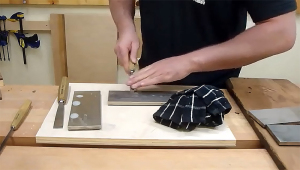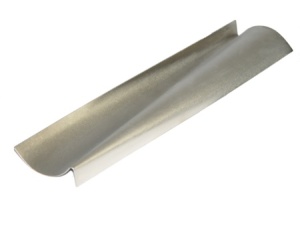A Sharpening Curmudgeon Gets a New Idea
 I’m a big fan of the sharpening school of thought that says, pick a method and stick with it til good at it before moving on to another method. The constant switching and “grass is greener” attitude can be detrimental to getting a good edge. Frankly I think every sharpening method, jig, wiz-bang gadget, and mystical, trance-like sharpening state is an effective way to get a sharp tool.
I’m a big fan of the sharpening school of thought that says, pick a method and stick with it til good at it before moving on to another method. The constant switching and “grass is greener” attitude can be detrimental to getting a good edge. Frankly I think every sharpening method, jig, wiz-bang gadget, and mystical, trance-like sharpening state is an effective way to get a sharp tool.
That’s the big news here folks, they all work.
They all are a good choice…if you learn how to use it/them. It is when you jump around with different methods that things start to break down. Without a baseline understanding of at least one method you have nothing to compare a new method to and more importantly you may never truly understand what “sharp” means. So pick something that you like based on cost or availability or the color of the box it comes in. It doesn’t matter just stick with it until you get consistent, sharp tools without having to think about it or read directions.
So here is where this dogma starts to break down.
Once you have invested a lot of time into your system of choice and it works, why would you change it? Why go in search of a new method if “it ain’t broke”?
This is exactly the thought that runs through my head whenever I see a new sharpening article or video. Maybe I’m stubborn or just practical but I don’t want to learn something all over again. Don’t try and make me or I’ll CUT YOU WITH MY STUPID SHARP TOOLS!!!
whew, deep breath….GOOZFRABA
I consider myself to be a very open minded person and I’m often experimenting with new joinery techniques and new tools in the thought that understanding multiple methods of cutting a tenon or planing a board will make me a better woodworker. Remember my video on the Allan Breed method of dovetailing or my experiment with cutting dados with a stair saw? These are perfect examples of the different arrow in my quiver way of thinking about woodworking.
But dammit, my free hand method on water stones and leather strop works great so I’m a close minded jerk on this point. To the point where I usually skip over sharpening stuff I see in magazines and online.
Until I saw this…
I don’t know what made me watch this video by Bill Schenher based on what I have said above, but watch I did. In fact it was almost a year ago that I first watched it. And that night for some reason I gave his side to side free hand technique a try for sharpening a carving gouge. Hmm, that is nice, that works really well. Previously I worked a curved edge forward and back while rolling the chisel and creating a diagonal line on my stones. It works great but it took a lot of practice to not alter my bevel angle when moving forward. Here is the video and the side to side technique comes in at about the 7 minute point. You should go visit Bill’s site too but I thought I would embed it here too for convenience.
This side to side method was so much easier right out of the gates. I had a much better feel of the bevel through my fingertips and I could actually feel where the stone was cutting and how my stroke needed to be changed to get right to the edges of the gouge. The physical motion is more in line with how my arms and shoulders naturally move so there was less having to lock stuff in place and more just going with the flow. This allows me to shift my focus onto other things like my mind meld with the Euclidean zero point. The primary drawback I saw was that it does not encourage even use of the stone and even my harder Shaptons would wear a groove quickly that would need to be flattened out.
So I bought a diamond stone. A DMT fine/extra fine stone that I would use just for this task on carving chisels. These things are expensive but I haven’t spend any money on sharpening stuff in at least 8 years so I figured I was due. That was a revelation in and of itself! Its not that diamond stones weren’t around when I bought water stones, but the selection wasn’t close to what it is today so they really weren’t an option. Now I can run back and forth all day long in one spot on the stone and I’m not wearing a groove into it. The stone cuts fast and it isn’t messy like a waterstone. Diamond isn’t friable like water stones so while you still get metallic swarf, you are not getting the stone gunk coming off too. I’m sure that this means you need to be vigilant about rinsing the stone to clear the swarf so that it won’t glaze and continue to cut, but I’m already doing that anyway with my water stones so that wasn’t a big learning curve for me.
In the end, 9 months later, this side to side method with a diamond stone is the only way I sharpen curved blades. From Scrub to Fore, to carving gouge they all get done the same way. I have even adopted this method for straight blades as I have a much more stable platform for free hand sharpening. From the extra fine diamond stone I still go to a leather strop and thats where I stay for some time before going back to a stone. But I use the same side to side stroke on the strop too.
Whether it is the actual sharpening method or the introduction of a diamond stone (I just bought another one too) I’m thankful I took my fingers out of my ears long enough to think to try a new sharpening method. I can actually say that I stuck with my first method long enough to master it and now I’ve been using the new method for 9 months and get consistent, sharp edges. It is better in my opinion. It is easier to learn and requires less extra stuff to deal with. Kudos to Bill for this excellent video that got me out of my routine and forced me to try something new.
Since Someone is Going to Ask
Here is what I’m using now:
- Regular old Norton 3X grinding wheel in a hand cranked grinder for restoration work
- DMT Fine/Extra Fine continuous diamond stone
- DMT Extra Extra Fine continuous diamond stone (my newest)
- DMT Wave Extra Fine for weird curvy stuff
- Leather strop with honing compound
I still have my Shapton Glasstones and won’t be getting rid of them anytime soon (their getting thin anyway) but I’m pretty invested in the diamond method right now.
Fight for Your Right to Sharpen How You Want
This post is not to state that my current method is the best or you should switch how you do things. Though I am pretty happy with it so if you are looking, give this a shot. The point I think that is most important is to keep an open mind, but fight hard to maintain your current method and don’t go easily into the seductive lure of a “new and better” sharpening method. When you grow tired of fighting, then you can try something new and have a strong understanding of where you are coming from and how the new method might be an improvement. The subtle differences from my old method to my new method would never be recognizable without SIGNIFICANT sharpening time on each.
Now I’m going to stick my fingers back in my ears for a few years and keep sharpening this way. Somebody shake me when an anti-matter collision insta-sharp method comes on the market and I’ll consider giving that a try.



